
Physiology News Magazine
Metabolism & Endocrinology Themed Meeting
Meeting Notes
Events
Metabolism & Endocrinology Themed Meeting
Meeting Notes
Events
Shalini Ojha, Helen Budge & Michael Symonds
University of Nottingham
https://doi.org/10.36866/pn.90.16
Brown adipose tissue: a new human organ?
11–13 December 2012, London, UK

Run by The Physiological Society, in partnership with the Academy of Medical Sciences, this meeting was held at The Royal Society and organised by Antony Vidal-Puig, Jan Nedergaard and Michael Symonds. It covered the subject from a multi-disciplinary standpoint, with focus on endocrinology, development and ageing, appetite and metabolic control, tissue imaging and thermoregulation.
Obesity is increasing at epidemic proportions and brown adipose tissue (BAT), with its role in body metabolism and energy expenditure, may provide one means of attenuating the growth of this problem. The meeting brought together leading researchers from across the world to discuss the recent advances in BAT research. BAT has emerged as a possible human organ with potentially a significant role in energy balance.
BAT is a thermogenic organ. In contrast to white adipose tissue, the primary function of BAT is to produce heat by the process of non-shivering thermogenesis. This process is enabled by the presence of a unique protein, uncoupling protein 1 (UCP1), which uncouples substrate oxidation from ATP production, releasing the energy liberated through oxidation directly as heat. The emergence of BAT in the forefront of metabolic discussions is fuelled by its recent (re)discovery in adult humans. The role of BAT in metabolism and energy balance was discussed, including new insights into physiological methods and pharmacological agents that can recruit BAT. For example, a role of BAT in diet-induced thermogenesis is highly controversial, and some new findings were presented which support the case for BAT involvement. These included human studies using thermal imaging and positron emission tomography combined with computed tomography (PET-CT) that demonstrated some evidence to support activation of BAT in response to meals.
The recent increased interest in brown-in-white or BRITE cells was discussed, and the meeting highlighted the role of several new transcription factors such as early B-cell factor 2 and other regulatory mechanisms involved in BAT physiology and its role in energy balance. At present, PET-CT scans remain the gold standard of imaging BAT, and recent data presented demonstrate that thermogenic responses decrease with age and that BAT activity is enhanced by cold acclimation and significant reduction in body mass index following bariatric surgery. Thermal imaging is a non-invasive and cost effective alternative modality for BAT imaging, and findings presented demonstrated the effects of mild cold exposure, diet and body mass index on the supraclavicular depot of BAT in humans. Other imaging modalities discussed include the use of magnetic resonance imaging in humans and experiments showing the delivery of lipophilic nutrients to brown adipocytes using superparamagnetic or fluorescent nanocrystals.
The role of BAT as an endocrine organ was also discussed. It is being recognised that BAT may have some role as a producer of hormones (e.g. triiodothyronine) and signalling molecules such as retinol-binding protein 4, which modulates insulin resistance and glucose metabolism, and adipokines such as interleukins and insulin-like growth factor and fibroblast growth factor. The involvement of BAT in lipoprotein metabolism was demonstrated by findings demonstrating the high uptake of lipids from lipoprotein by brown adipocyte.
It was apparent from the meeting that BAT research is entering a new exciting and dynamic phase which was highlighted by the advances currently being made. These studies have potential to produce translational research for the prevention and treatment of obesity and associated metabolic conditions.

An undergraduate experience

Caroline Bull
3rd year Human Physiology BSc student, University of Leeds
The opportunity to attend the recent Metabolism & Endocrinology Themed Meeting was granted to me as a recipient of The Physiological Society’s early careers bursary. As a third year undergraduate this was an invaluable experience, not least to experience the environment of a professional conference, but also because of the topic, and the excitement surrounding the field of brown adipose tissue.
It was an honour to communicate with researchers of such calibre and to be able to put faces to names behind papers that I had come across in the literature. I enjoyed stretching my knowledge in order to understand the different experimental techniques and approaches outlined by the speakers. The work discussed by Alexander Bartelt of The University Medical Centre, Hamburg- Eppendorf stood out as particularly elegant. I also found the presentation by Michael Symonds of Nottingham University detailing the development and role of BAT in early life engaging.
The researchers’ enthusiasm was central to the meeting and it was great to experience this atmosphere as an undergraduate hoping to pursue academia in a similar field. A highlight of the meeting was Francesc Villarroya describing the understanding of BAT as ‘sexy science’, a statement that greatly contradicted the nature of family and friends’ reactions when I mentioned that I was attending a conference on brown fat!
The conference dinner, hosted at the Churchill War Rooms was thoroughly enjoyable and appropriate to show the international attendees of the conference the charm of London. Having had such a positive experience at my first conference with The Physiological Society, forthcoming conferences have a lot to live up to!
